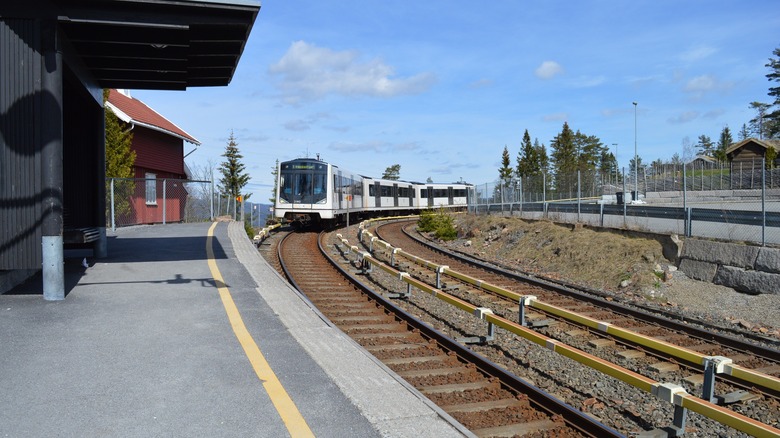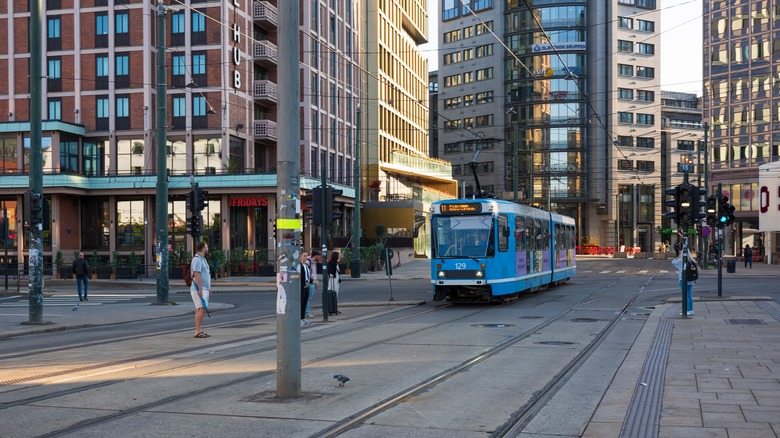Europe's Best Subway System Is In A Country Full Of Rich History And Natural Beauty
Public transportation is often a mess, and subway systems can crank up the stress just as much as airports. From squeezing into packed train cars during rush hour to navigating indecipherable maps, commuting, especially in unfamiliar territory, can feel like a nightmare. Take New York City's infamous chaotic subway, for instance — it's practically a maze that could make even seasoned commuters break a sweat. And despite its reputation, Europe's transit systems aren't always the seamless dream they're made out to be. Inefficiencies in some cities' subways can cause headaches, and tourists are especially prone to making pricey and hard-to-avoid mistakes. But if you want to break free from transit chaos and have a train experience that doesn't feel like you're being put through an endurance test, make your way to Norway, specifically, Oslo — the city that's been crowned home to the best subway system in all of Europe.
Sure, Oslo might not win any awards for being a walkable city (it's actually voted for being one of the least walkable), but its metro system more than makes up for it. According to The Underground Index analysis report conducted by luggage storage company Bounce in 2024, the Oslo Metro (also known as the Oslo T-Bane and T-banen i Oslo), ranked first in Europe, snagging an impressive 8.06 out of 10 score, managing to beat out cities like Sofia, Athens, and Madrid. The system boasts a massive network of 101 stations and five lines, with a sixth on the way, covering all of Oslo's boroughs and even parts of Baerum. But despite its size, it reportedly runs like a well-oiled machine — efficient, reliable, and shockingly easy to navigate. Locals and tourists alike can't stop gushing about its punctuality and user-friendliness, making it one of those rare subway systems that, dare we say, actually does what it's supposed to. Imagine that!
Locals and tourists shower the Oslo subway system with love
No subway system is flawless, but the Oslo Metro seems to come pretty close. According to Bounce's report, it snagged an impressive 4.13 out of 5 across all its 101 stations on Google reviews, even at Jernbanetorget, the busiest hub in the system. Travelers rave about it being not just pretty much spotless and a breeze to navigate, but "very well organized," a rarity in the world of public transport.
And the locals are backing it up. The European Commission's 2023 Survey on the Quality of Life in European Cities shows Oslo's public transportation satisfaction at 88%, placing it third in Europe, right behind Vienna and Helsinki. Sure, it's not winning any awards for affordability, but it excels where it counts: second in safety (92%), ninth in ease of access (89%), fourth in frequency (88%), and seventh in overall reliability (83%). As one local summed it up on Reddit: "The trains are always clean and the metro trains are the largest that I've ever been in, so except in rush hour there's always a lot of space. From Majorstuen to Tøyen stations in the city center, all lines share the same tunnel so you rarely have to wait more than a minute for a train."
Oslo Metro isn't just efficient, it's also serving up amazing views. Thanks to having the largest altitude variation of any metro in the world, it takes you from the city's lowest points to its highest peaks, with routes surrounded by nature that'll make your commute feel more like a scenic escape. Pro tip from Visit Oslo: "Take the metro line 1 towards Frognerseteren and get off at the Holmenkollen stop. Walk one minute up the hill and you see this view of the city!"
Oslo's transport network is on track to achieve zero emissions
Norway isn't stopping at a top-tier subway system. With its laser focus on sustainability, Oslo is set to become an emissions-free city by 2030. And they're not just talking about it — Norway's already pouring serious resources into electrifying the city's public transit. We're not just talking trains, either. Trams, ferries, and buses are all going electric. Norway aimed to ditch diesel buses by 2023, though it's still unclear if they hit that target. But considering most of Oslo's public transport already runs on renewable energy, it's safe to say things are moving full steam ahead."Emission-free public transport makes Oslo a better city to live in, with less air pollution and less noise," Øystein Dahl Johansen, spokesperson for Oslo's public transport system, Ruter, told Warp News.
It's not just about cutting emissions, though — it's also about improving the everyday lives of Oslo's residents, and of course, the people who visit it, too. Ruter's Planning Director, Snorre Lægran, explained to Lampoon Magazine that electrifying public transit is about more than just climate goals: "This goal is based on needs beyond climate, such as better air quality, less congestion in the city center and residential areas, and better road traffic safety. Significant health benefits come with increased walking and cycling, and fulfilling these goals facilitates better public health and a more human-friendly urban development." It's really no wonder why Rick Steves picked Norway as the European country he'd be glad to live in.

